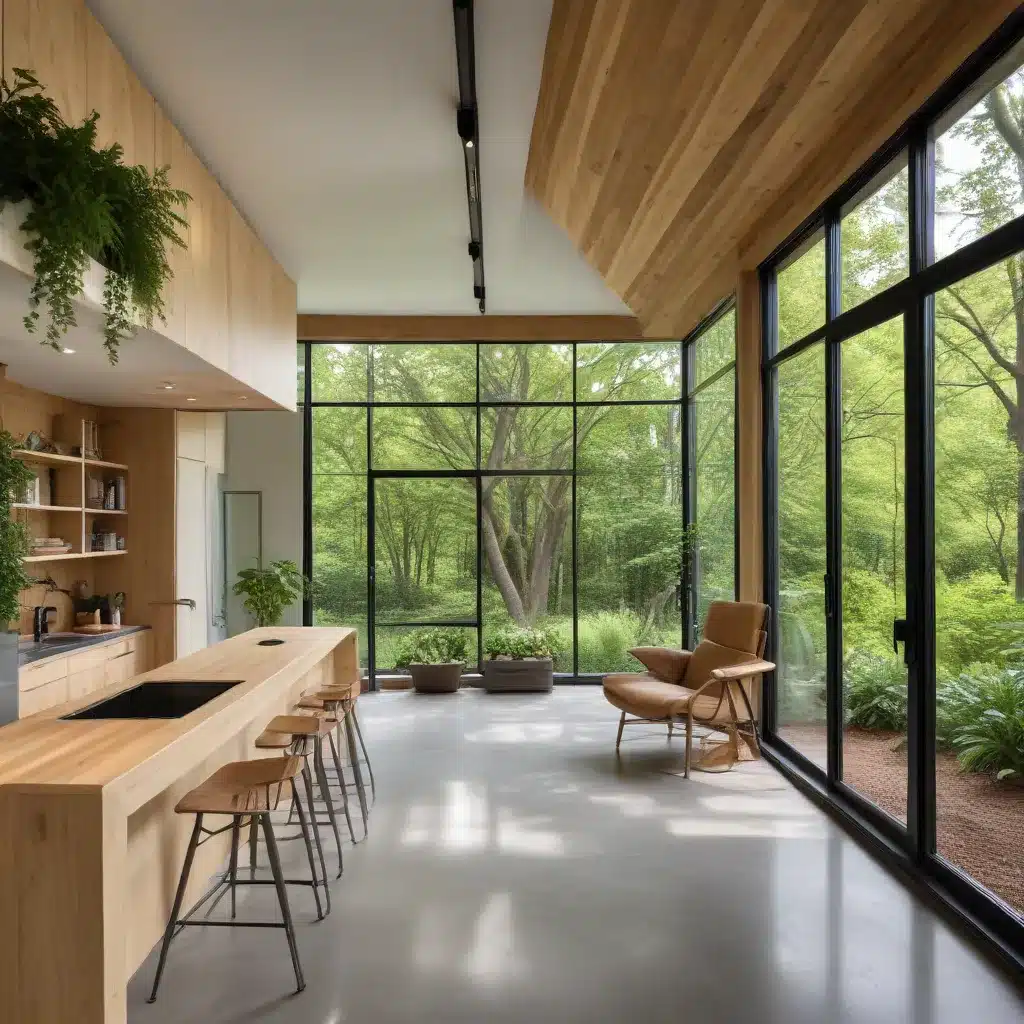
As an experienced home improvement consultant passionate about sustainable design, I’m excited to share insights on how you can transform your living spaces through the power of biophilic design. Whether you’re tackling a full-scale renovation or seeking to enhance your home’s eco-credentials, incorporating nature-inspired elements can breathe new life into your environment while delivering tangible benefits for your health, wallet, and the planet.
Biophilic Design Fundamentals
Biophilic design is an architectural approach that prioritizes our innate connection to the natural world. By strategically integrating elements like greenery, natural light, and organic materials, biophilic spaces can reduce stress, boost productivity, and foster a greater sense of wellbeing. At its core, biophilic design mimics the patterns, textures, and sensory experiences we instinctively crave from the great outdoors.
The 14 Patterns of Biophilic Design outlined by Terrapin Bright Green provide a comprehensive framework for infusing nature into our built environments. These patterns range from Visual Connections (views of living elements) to Thermal & Airflow Variability (embracing natural temperature fluctuations) to Complexity & Order (replicating the fractal geometries found in nature). Each pattern offers unique opportunities to enhance both the aesthetics and functionality of a space.
The benefits of biophilic design are well-documented. Studies show that access to natural elements can lower blood pressure, improve cognitive function, and accelerate healing. Incorporating biophilic principles into your renovation plans is a smart investment in both your family’s well-being and the long-term sustainability of your home.
Sustainable Material Selection
Selecting eco-friendly materials is a crucial step in any sustainable renovation. Look for renewable resources like bamboo, cork, and reclaimed wood that minimize environmental impact during extraction and processing. Recycled plastics, metals, and glass are also excellent choices, as they divert waste from landfills and reduce the demand for virgin materials.
Beyond material selection, focus on low-impact construction techniques that conserve energy and resources. For example, prefabricated building components can significantly reduce construction waste, while passive design strategies like strategic window placement and high-efficiency insulation can slash your home’s operational energy needs.
Calculating and minimizing a renovation’s embodied carbon footprint is another important consideration. Embodied carbon refers to the greenhouse gas emissions associated with a material’s entire life cycle, from raw material extraction to end-of-life disposal. By opting for materials with lower embodied carbon, you can dramatically shrink your renovation’s environmental impact.
Optimizing Natural Ventilation
Harnessing the power of nature is a cornerstone of biophilic design. Passive cooling strategies like operable windows, high ceilings, and strategically placed vents can create natural airflow and reduce your reliance on energy-hungry HVAC systems. Couple these features with dynamic lighting controls that respond to changing daylight levels, and you’ll enjoy a healthier, more comfortable indoor environment while slashing your utility bills.
Improving indoor air quality is another crucial aspect of sustainable renovations. Look for low-VOC paints, sealants, and adhesives that minimize the release of harmful chemicals. Incorporating greenery and natural air purifiers like spider plants or peace lilies can also scrub toxins from the air and infuse your spaces with a fresh, rejuvenating atmosphere.
Incorporating Greenery and Landscaping
No biophilic renovation is complete without the addition of lush greenery. Living walls and green roofs don’t just beautify a space – they also provide valuable ecosystem services like air filtration, stormwater management, and urban heat island reduction. When planning your outdoor areas, prioritize native, drought-tolerant plants that support local pollinators and minimize maintenance demands.
For a truly immersive biophilic experience, design integrated indoor-outdoor spaces that blur the line between nature and the built environment. Strategically placed sliding doors, large windows, and covered patios can cultivate a seamless transition between your home and the great outdoors. Don’t forget to incorporate water features like fountains or reflecting pools, which can promote a soothing, restorative ambiance.
Enhancing Occupant Wellbeing
Beyond the environmental benefits, biophilic design delivers tangible improvements to human health and productivity. Exposure to natural light, greenery, and organic materials has been shown to reduce stress, boost creativity, and enhance cognitive function. By catering to our deep-rooted affinity for the natural world, biophilic renovations can create spaces that nourish the body, mind, and spirit.
Consider incorporating flexible, multi-purpose areas that allow your family to adapt the space to their evolving needs. Designate cozy nooks and alcoves for focused work or quiet contemplation, balanced by open, light-filled gathering zones that encourage social interaction and movement. The strategic placement of natural elements like plants, water features, and daylight can enhance the restorative qualities of each zone.
Regulatory Frameworks and Certifications
As public awareness of sustainability grows, municipalities and green building organizations have developed a range of regulatory frameworks and certification programs to encourage eco-friendly construction. Familiarize yourself with standards like LEED, WELL, and Fitwel, which offer guidance and recognition for biophilic design strategies.
Many local governments also provide incentives and rebates for homeowners who incorporate sustainable features into their renovations. These can include everything from property tax abatements to expedited permitting to cash rebates for energy-efficient upgrades. Researching the specific programs available in your area can help offset the upfront costs of your biophilic renovation.
By embracing the principles of biophilic design, you can transform your living spaces into healthy, sustainable havens that nurture both the environment and your family’s wellbeing. Whether you’re tackling a whole-home overhaul or seeking strategic upgrades, the integration of nature-inspired elements can deliver enduring benefits for years to come. For more inspirational ideas and expert advice, be sure to visit Reluctant Renovator – your go-to source for eco-friendly, family-friendly home improvement.



